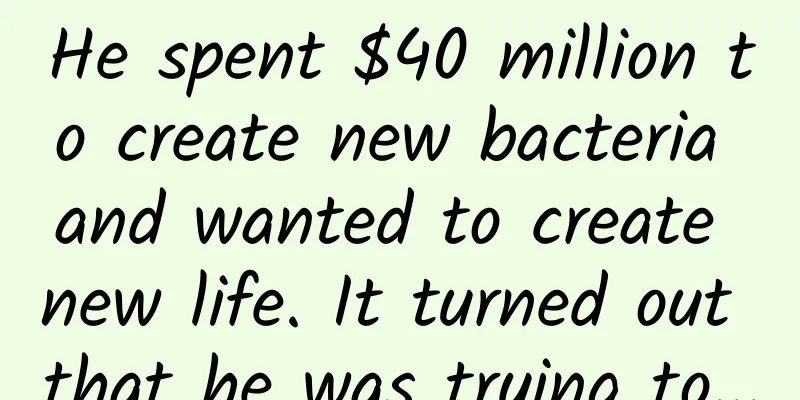He spent $40 million to create new bacteria and wanted to create new life. It turned out that he was trying to...

|
Nobel Prize winner and famous physicist Richard Feynman once said, "What I cannot create, I do not understand", which means that if I cannot create something, I cannot understand it. This view also applies to the understanding of life. Only when we are able to create life can we truly understand the essence of life, which is what research in the field of life sciences has always wanted to achieve. So, how do we create life? A basic rule in the field of life science is the "central dogma", which states that genetic information can replicate itself from DNA and can also be transferred to RNA, and then from RNA to protein, completing the transcription and translation process of genetic information. This process is the process of creating life. Therefore, theoretically, as long as we can create DNA, it will be possible to artificially create life and gain a deeper understanding of the essence of life. The history of human "artificial life" development Artificial life refers to extracting genes from other life forms, creating new artificial chromosomes, and then transferring them into cells from which the genetic material has been removed. Ultimately, these artificial chromosomes control the cell and develop it into a new life form. Although the development of artificial life is relatively short, it is full of innovations and breakthroughs. In 1953, Watson and Crick proposed the famous DNA double helix structure model, which opened the era of molecular biology. In the 1970s, Herbert Boyer and Stanley Cohen respectively achieved the cleavage of double-stranded DNA by restriction endonucleases and the transfer of plasmid DNA into Escherichia coli. These two innovative achievements marked the birth of genetic engineering. Subsequently, the DNA sequencing technology invented by Sanger achieved the accurate "reading" of DNA sequences. Then, Paul Berg and Walter Gilbert further promoted the development of recombinant DNA technology by developing molecular cloning technology. These groundbreaking technologies have laid an important foundation for the research of artificial life. Among them, the achievement made by the team of American biologist Craig Venter in May 2010 marked a major breakthrough in the field of artificial life. They chemically synthesized an entire genome in the laboratory and then implanted the synthetic genome into an empty cell. The cell then began to replicate and proliferate according to the implanted genetic instructions, eventually forming new cells. Although some scientists have reservations that Venter's work is based only on a natural, pre-existing remnant cell and does not create real life, his experiment still proves that an artificial genome can power cells, which provides important insights for the future of true artificial life. The Mad Scientist of Artificial Life: Craig Venter When it comes to artificial life, we have to mention the leader and scientific madman in this field - Craig Venter. He is a famous American biologist and entrepreneur, known for his major achievements in the scientific community. His achievements include "taking on scientists from six countries alone to complete the human genome project" and "creating new organisms", both of which are breakthroughs that shocked the scientific community around the world. In the 1990s, top scientists from six countries including the United States, Britain, France, Germany, Japan and China jointly participated in the Human Genome Project, which was expected to cost $3 billion to complete the sequencing of the human genome. However, when half of the time and money were spent, they had only completed 3% of the sequencing work. At the same time, Craig Venter founded Celera Genomics, a private genetic research institute, developed new sequencing technologies such as "shotgun", and quickly caught up with the progress of the multinational collaboration team. Later, Craig Venter worked with scientists from six countries to successfully complete the draft of the human genome in early 2001. After the completion of the Human Genome Project, Craig Venter soon had a new ideal, which may be the ultimate goal of life science: to create new life forms . Craig Venter planned to use small fragments of DNA to synthesize a new genome and transfer it into bacteria that had their own genome removed to observe whether the tiny bacteria could metabolize and reproduce. After more than a decade of unremitting efforts and spending more than $40 million, Craig Venter's research team finally created a new bacterium in 2010. Craig Venter believes that "this is the first species on Earth that can replicate itself even though its parents are computers." Currently, Craig Vent has launched a series of new studies. He converted his yacht into a research vessel and led his team members to the Sargasso Sea near the Bermuda Islands, hoping to use local materials to draw a genome map of all microorganisms in the ecosystem of the sea area. Craig Vent's ultimate goal is to use the genes found in the ocean to design a new life form. These lives will have the ability to capture carbon dioxide, curb the greenhouse effect, clean up nuclear waste, and produce a large number of hydrogen atoms. The development of this new life form is expected to change the status quo of the global energy economy. Craig Venter's research journey has gone from sequencing the human genome to artificially synthesizing bacteria, to finding beneficial genes from the ocean to design new life, and has always been guided by a main theme: **From genes to life. **Whether it is understanding genes, synthesizing genes, or finding new genes, all of Craig Venter's research is to draw a blueprint for creating life and ultimately realize the mission of artificial life, answering the important question of "can science really create life?" A breakthrough in the synthesis of yeast artificial chromosomes Bacteria and yeast are typical representatives of prokaryotes and eukaryotes, respectively. Being able to synthesize the genomes of these two can lay an important theoretical foundation for synthetic life and enrich the knowledge reserve of artificial life. As a prokaryotic bacteria, it took scientists more than ten years to synthesize its genome and create a new life. As a eukaryotic yeast, its genome has 16 chromosomes, and the complexity and difficulty of synthesis can be imagined. To this end, the international community launched the Yeast Genome Synthesis Project (Sc2.0), which is the first attempt by humans to design and synthesize the genome of eukaryotic organisms from scratch, aiming to redesign and synthesize all 16 chromosomes of Saccharomyces cerevisiae. The project was launched in 2011 and is jointly participated by more than 200 scientists from China, the United States, the United Kingdom, Singapore, Australia and other countries. The researchers faced many challenges in synthesizing the yeast genome sequence from scratch. Due to the large number of repetitive sequences in the yeast genome, they removed transposons and repetitive elements and recoded the stop codon. At the same time, the researchers deleted, inserted and replaced bases in the gene sequence to ensure that the synthetic strain had the same phenotype as the natural strain while also ensuring the stability of the genome. The yeast genome structure model shown on the cover of Science in 2017, where gold represents fully synthesized chromosomes and white represents natural chromosomes (Image source: Science official website) Based on the above principles and standards, in 2014, a research team led by Professor Jef Boeke of New York University successfully created the first artificial yeast chromosome, the smallest chromosome 3. This achievement opened the precedent for eukaryotic genome synthesis. By 2017, the Sc2.0 team had completed the synthesis of 5 of the 16 chromosomes in the yeast genome, 4 of which were completed by Chinese scientists. Specifically, the team led by Academician Yuan Yingjin of Tianjin University was responsible for the synthesis of chromosomes 5 and 10; the team led by Researcher Dai Junbiao of Tsinghua University was responsible for the design and synthesis of chromosome 12; and the team led by Academician Yang Huanming of BGI was responsible for the de novo design and full synthesis of yeast chromosome 2. By 2023, the Sc2.0 project has reached a new milestone. The team led by Shen Yue, a researcher at BGI, has completed the de novo design and full synthesis of yeast chromosomes 7 and 13, as well as the construction of a new tRNA chromosome. This marks the successful completion of the synthesis of all 16 chromosomes of yeast. In addition, the team has successfully constructed a yeast strain containing 50% synthetic DNA, which can not only proliferate actively, but also exhibit normal cell morphology, length and shape. In 2023, an article published in Cell described the integration process of yeast chromosomes: yeast cells containing different synthetic chromosomes were hybridized, and individuals carrying two synthetic chromosomes were found in the offspring. After a long hybridization process, scientists gradually integrated all the chromosomes they had previously synthesized (6 complete chromosomes and 1 chromosome arm) into the same cell (Image source: Reference [5]) Chinese scientists participating in the yeast genome synthesis project, from left to right: Li Bingzhi, Dai Junbiao, Yang Huanming, Yuan Yingjin, Shen Yue (Photo source: People's Daily) Artificial cells upgraded again : close to real living cells Artificially synthesized bacteria and yeast mainly solve the problem of genome synthesis, but living cells still rely mainly on proteins to perform functions. On April 23, 2024, American scientists published a new research result in the journal Nature Chemistry. They created artificial cells similar to human cells by manipulating DNA and proteins. This result is of great significance to the fields of regenerative medicine, drug delivery and diagnostic tools. The cytoscaffold is an important scaffold structure inside the cell, composed of a series of dynamic polymers. It plays an important role in key processes such as cell division, movement and morphogenesis. Without the cytoscaffold, the structure and function of the cell will be affected. The cytoscaffold of natural cells is complex and reconfigurable. It can assemble at different locations and dynamically adjust its own structure and mechanical properties. Peptides are a very promising material for building artificial cytoskeleton. Currently, scientific researchers have widely studied the rational design of peptides to enable them to self-assemble into various structures. However, the ability to realize peptide-based systems in cell-mimicking restricted environments is still very limited. The main components of cells and tissues are proteins, which play an indispensable role in the formation of cell scaffolds. Normally, DNA does not appear in cell scaffolds, but the researchers in this study reprogrammed the DNA sequence to become a "building material" that combines with protein elements - peptides to form a new type of cell scaffold that can change shape and respond to the surrounding environment. This is a new idea for artificial cells. In fact, reprogramming DNA is not the first time. In a study published in Nature Communications in 2023, researchers demonstrated that five oligonucleotides (DNA) can be annealed into nanotubes or fibers with adjustable thickness and length spanning four orders of magnitude. These structures are integrated into cell-like vesicles and wrapped around the outside of the vesicles—acting as cell scaffolds. DNA reprogramming strategies can be used for the bottom-up design of synthetic cells and tissues, as well as the generation of medical smart material devices. Reprogramming DNA means scientists can create new cells with specific functions and even fine-tune how cells respond to external stress. While living cells are more complex than synthetic cells, they are also more susceptible to harsh environments such as high temperatures, while synthetic cells are stable even at 50°C, which opens up the possibility of making cells in environments that are not suitable for human life. Synthetic cells can be loaded with almost any drug molecule. By adding tiny magnetic particles and using magnets outside the body for precise guidance, they can be targeted to small areas with high doses without affecting other parts of the body. For example, in cancer treatment, loading anti-cancer drugs with synthetic cells can improve the effectiveness of the drugs and significantly reduce potential damage to cells in other parts of the body. The research team said that this study will help humans understand life. Synthetic cell technology not only allows scientists to "copy" the functions of nature, but is also expected to bring major changes to fields such as biotechnology and regenerative medicine. Synthetic cell scaffolds constructed using peptide-DNA nanotechnology (Image source: Reference [6]) Conclusion The study of artificial life is an important way for humans to understand life. At present, scientists have achieved artificial synthesis of bacteria, semi-synthetic yeast and artificial cells that are more like living cells. This not only promotes the development of life sciences, but also makes important contributions to the development of regenerative medicine while constantly creating complex new life. Perhaps in the near future, humans will be able to artificially synthesize healthy organ tissue cells to replace damaged or diseased tissues, thereby extending the healthy life span of humans. This not only reflects the progress of science and technology, but also marks a further deepening of our understanding of the essence of life. References [1]Gibson et al. Complete Chemical Synthesis, Assembly, and Cloning of a Mycoplasma genitalium Genome. Science, 2008, 319(5867): 1215-1220. [2]Gibson et al. Creation of a Bacterial Cell Controlled by a Chemically Synthesized Genome. Science, 2010, 329(5987): 52-56. [3]Xie et al. “Perfect” designer chromosome V and behavior of a ring derivative. Science, 2017, 355, eaaf4704 [4]Schindler et al. Design, Construction, and Functional Characterization of a tRNA Neochromosome in Yeast. Cell, 2023. DOI: 10.1016/j.cell.2023.10.015 [5]Zhao et al. Debugging and consolidating multiple synthetic chromosomes reveals combinatorial genetic interactions. Cell, 2023, 186: 5220–5236 [6]Daly et al. Designer peptide–DNA cytoskeletons regulate the function of synthetic cells. Nature Chemistry, 2024. Planning and production Produced by Science Popularization China Author: Denovo team Producer丨China Science Expo Editor: Yinuo Proofread by Xu Lailinlin |
>>: Without the Sahara Desert, perhaps there would be no Amazon rainforest?
Recommend
Cold wave hits South China! National down jacket warning map released, more than three quarters of the country needs to wear down jackets
Cold wave hits South China, more than three quart...
Why electric vehicles make China the global automotive center of the 21st century
Globally, automakers and governments are making b...
How to advertise with a budget of less than 100,000?
The 100,000 refers to the monthly budget, not the...
I want to listen to two songs at the same time, brain: No, I can't do that
I wonder if you have ever had this experience: If...
Most of the time, no one reads your information flow copy because of this mistake!
When writing copy for a product or promotion , ma...
Quantum mechanics hidden in a tiny window? So I advise you to close the curtains at night!
With the continuous development of urbanization, ...
Beware! Don’t touch this kind of “milk tea cup”
Recently, there has been a Outer packaging Toys s...
What is Web Hosting? What are the advantages and disadvantages of shared hosting?
After the website is completed, where should it b...
The game is paused. What did you just say about Ma Mei? | Expo Daily
Your best "insider" in the scientific c...
How to attract new customers through online and offline activities!
I recently watched some videos on Bilibili. There...
Technology and hard work? Can you eat hot pot meatballs safely?
As the weather gets colder, many people fall in l...
The irresistible "bloody romance"
In early 1799, Jiaqing finally breathed a sigh of...
New energy vehicle stock prices fell, and the net worth of the founders of NIO, Li Auto and Xpeng evaporated by tens of billions of dollars
Tesla is not the only company whose stock price h...
How to sell goods through live streaming on Douyin?
Live streaming sales on Douyin is one of the hott...
Android teaches you how to interact with WebView and JS in five minutes
[[189497]] Background: Android API provides WebVi...









